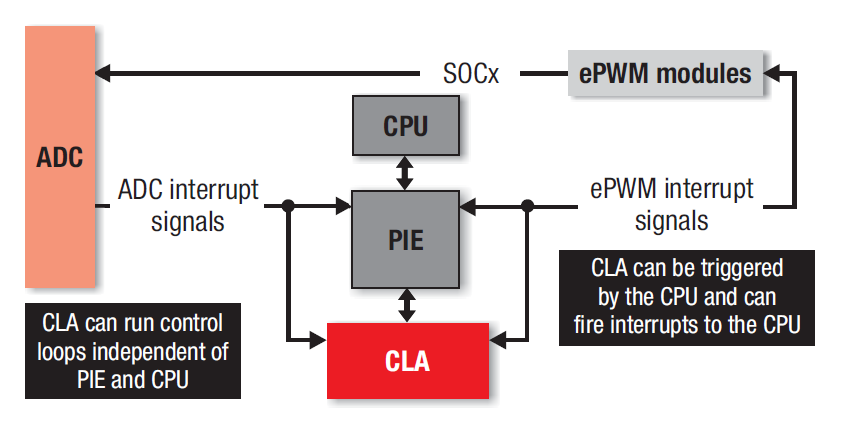SPRACN0F October 2021 – March 2023 F29H850TU , F29H859TU-Q1 , TMS320F280021 , TMS320F280021-Q1 , TMS320F280023 , TMS320F280023-Q1 , TMS320F280023C , TMS320F280025 , TMS320F280025-Q1 , TMS320F280025C , TMS320F280025C-Q1 , TMS320F280033 , TMS320F280034 , TMS320F280034-Q1 , TMS320F280036-Q1 , TMS320F280036C-Q1 , TMS320F280037 , TMS320F280037-Q1 , TMS320F280037C , TMS320F280037C-Q1 , TMS320F280038-Q1 , TMS320F280038C-Q1 , TMS320F280039 , TMS320F280039-Q1 , TMS320F280039C , TMS320F280039C-Q1 , TMS320F280040-Q1 , TMS320F280040C-Q1 , TMS320F280041 , TMS320F280041-Q1 , TMS320F280041C , TMS320F280041C-Q1 , TMS320F280045 , TMS320F280048-Q1 , TMS320F280048C-Q1 , TMS320F280049 , TMS320F280049-Q1 , TMS320F280049C , TMS320F280049C-Q1 , TMS320F28374D , TMS320F28374S , TMS320F28375D , TMS320F28375S , TMS320F28375S-Q1 , TMS320F28376D , TMS320F28376S , TMS320F28377S , TMS320F28377S-Q1 , TMS320F28378D , TMS320F28378S , TMS320F28379D , TMS320F28379D-Q1 , TMS320F28379S , TMS320F28384D , TMS320F28384S , TMS320F28386D , TMS320F28386S , TMS320F28388D , TMS320F28388S , TMS320F28P650DH , TMS320F28P650DK , TMS320F28P650SH , TMS320F28P650SK , TMS320F28P659DH-Q1 , TMS320F28P659DK-Q1 , TMS320F28P659SH-Q1
- The Essential Guide for Developing With C2000™ Real-Time Microcontrollers
- Trademarks
- 1C2000 and Real-Time Control
-
2Sensing Key Technologies
- 2.1 Accurate Digital Domain Representation of Analog Signals
- 2.2 Optimizing Acquisition Time vs Circuit Complexity for Analog Inputs
- 2.3 Hardware Based Monitoring of Dual-Thresholds Using a Single Pin Reference
- 2.4 Resolving Tolerance and Aging Effects During ADC Sampling
- 2.5 Realizing Rotary Sensing Solutions Using C2000 Configurable Logic Block
- 2.6 Smart Sensing Across An Isolation Boundary
- 2.7 Enabling Intra-Period Updates in High Bandwidth Control Topologies
- 2.8 Accurate Monitoring of Real-Time Control System Events Without the Need for Signal Conditioning
-
3Processing Key Technologies
- 3.1 Accelerated Trigonometric Math Functions
- 3.2 Fast Onboard Integer Division
- 3.3 Hardware Support for Double-Precision Floating-Point Operations
- 3.4 Increasing Control Loop Bandwidth With An Independent Processing Unit
- 3.5 Flexible System Interconnect: C2000 X-Bar
- 3.6 Improving Control Performance With Nonlinear PID Control
- 3.7 Understanding Flash Memory Performance In Real-Time Control Applications
- 3.8 Deterministic Program Execution With the C28x DSP Core
- 3.9 Efficient Live Firmware Updates (LFU) and Firmware Over-The-Air (FOTA) updates
-
4Control Key Technologies
- 4.1 Reducing Limit Cycling in Control Systems With C2000 HRPWMs
- 4.2 Shoot Through Prevention for Current Control Topologies With Configurable Deadband
- 4.3 On-Chip Hardware Customization Using the C2000 Configurable Logic Block
- 4.4 Fast Detection of Over and Under Currents and Voltages
- 4.5 Improving System Power Density With High Resolution Phase Control
- 4.6 Safe and Optimized PWM Updates in High-Frequency, Multi-Phase and Variable Frequency Topologies
- 4.7 Solving Event Synchronization Across Multiple Controllers in Decentralized Control Systems
- 5Interface Key Technologies
- 6Safety Key Technologies
- 7References
- 8Revision History
3.4.2 In Depth
The CLA found on the devices listed below is a fully parallel processor to the main C28x core. While the C28x core is a more traditional processor, executing instructions and servicing interrupts, the CLA is a task driven state machine. The CLA is a 32-bit floating point architecture.
Due to the nature of control systems, there are specific times when the sensing subsystem has new data to be processed. Advanced planning for these events with the other functions of an MCU can be difficult to time slice without introducing delay into both the system under control, but also any other functions the CPU has to perform.
As a task driven state machine, the CLA is constantly waiting in an idle state for an event, such as an ADC conversion, to process that data and actuate the system. Additionally, the CLA has full access to key control peripherals so it can fully realize the control system independent of the C28x CPU (#T5843526-186).
 Figure 3-6 C28x and CLA Interfacing With the ADC and ePWM Modules
Figure 3-6 C28x and CLA Interfacing With the ADC and ePWM ModulesThe above is beneficial for many reasons:
- There is little to no delay in processing the data, typically caused by the context switching of the main C28x core, and applying the new external stimulus to the system.
- There is no interruption or impact to the current C28x program execution.
- Potential to have parallel control systems running independently on the same MCU device.
The CLA has its own dedicated memory region for its code and shared memory for passing information between it and a C28x CPU in the system. The CLA is supported in Code Composer Studio™ by its own C compiler.